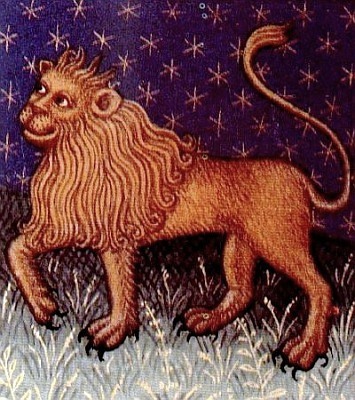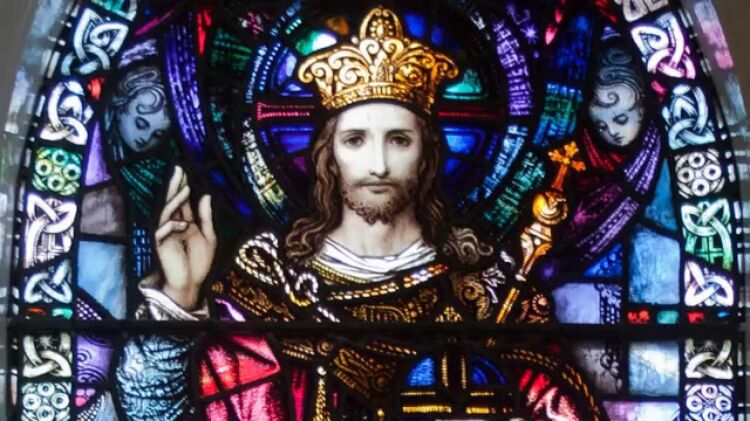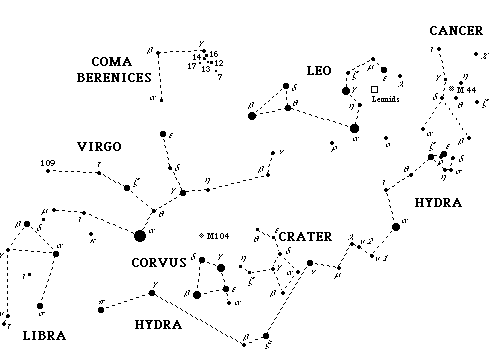|

In the 5th book of St. John's Apocalypse, in verses 1-5, we read,
And I saw in the
right hand of him that sat on the throne, a book written within and
without, sealed with seven seals. And I saw a strong angel, proclaiming
with a loud voice: Who is worthy to open the book, and to loose the
seals thereof? And no man was able, neither in heaven, nor on earth,
nor under the earth, to open the book, nor to look on it. And I wept
much, because no man was found worthy to open the book, nor to see
it. And one of the ancients said to me: Weep not; behold the lion
of the tribe of Juda, the root of David, hath prevailed to open the
book, and to loose the seven seals thereof.
That Lion of the Tribe of Juda, the root of David, is Christ
Himself. It is He Who will open the book that was closed up with seven
seals, the opening of which will bring on the tribulations the people
on
earth, including those of the Church, will endure before the Last
Judgment we saw with the
Sign
of
Cancer.
Our Lord's title of "the Lion of the Tribe of Juda" stems
from Jacob's words to his twelve sons, each the head of one of the 12
tribes of Israel. To his son Juda, he said, in Genesis 49:8-9, "Juda is
a lion' s whelp: to the prey, my son, thou art gone up: resting thou
hast couched as a lion, and as a lioness, who shall rouse him? The
sceptre shall not be taken away from Juda, nor a ruler from his thigh,
till he come that is to be sent, and he shall be the expectation of
nations." It is from the Tribe of Judah, the House of David, that Jesus
comes, both through the genealogy of His Mother, but also, by
inheritance, through the genealogy of His earthly father, St. Joseph.
Lions have long been a symbol of royalty, and the words of Jacob
indicate Christ's Kingship when he speaks of the sceptre that shall not
be taken away from Juda. With the Sign of Leo coming after the Last
Judgment, everyone who's ever lived will realize what we Catholics
already know: that Christ is, was, and always shall be King, a fact we
celebrate with the Feast of
the Kingship of Christ, on the last Sunday of October, just before
Advent, a season that brings us back to the meaning of the Sign of
Virgo which comes next, beginning the next repetition of the Zodiacal
cycle. Regulus is the brightest star (actually, a star system of four
stars that appear as one to us) in the constellation, and the fifteenth
brightest star of the Northern hemisphere; it makes up the
heart of the lion, and its name also means "King." The Babylonians knew
it as "King," as well (Sharru),
and the astronomers of India call it "Mighty" (Magha).
Just after the description of the second death in the Apocalypse, we
read the words "And there came one of the seven angels, who had the
vials full of the seven last plagues, and spoke with me, saying: Come,
and I will shew thee the bride, the wife of the Lamb. And he took me up
in spirit to a great and high mountain: and he shewed me the holy city
Jerusalem coming down out of heaven from God..." We then read about the
Heavenly Jerusalem, about which we were told,
And I John saw
the holy city, the new Jerusalem, coming down out of heaven from God,
prepared as a bride adorned for her husband. And I heard a great voice
from the throne, saying: Behold the tabernacle of God with men, and He
will dwell with them. And they shall be His people; and God himself
with them shall be their God. And God shall wipe away all tears from
their eyes: and death shall be no more, nor mourning, nor crying, nor
sorrow shall be any more, for the former things are passed away. And He
that sat on the throne, said: Behold, I make all things new. And He
said to me: Write, for these words are most faithful and true.
The penultimate verse of Apocalypse reads, "He that giveth
testimony of these things, saith, Surely I come quickly: Amen. Come,
Lord Jesus," a perfect segue back to the Sign of Virgo,
the Sign that
recalls the Incarnation and Birth of Jesus. At Advent, though, we anticipate more than
just
the Nativity of Our Lord; we anticipate the Nativity and the
triumphant return of Lord Christ. Dom Gueranger puts it best, showing
us how Virgo, with its signifying the first coming of Christ, so aptly
follows Leo, foretelling His return:
This, then, is
the mystery of Advent. Let us now listen to the explanation of this
threefold visit of Christ, given to us by Peter of Blois, in his third
sermon de Adventu: 'There are three comings of our Lord; the first in
the flesh; the second in the soul; the third at the judgment.
The first
was at midnight according to those words of the Gospel: At Midnight
there was a cry made, Lo, the Bridegroom cometh! But this first coming
is long since past for Christ has been seen on the earth and has
conversed among men.
We are now in the second coming, provided only we
are such as that He may thus come to us; for He has said that if we
love Him, He will come unto us and take up His abode with us. So that
this second coming is full of uncertainty to us; for who, save the
Spirit of God, knows them that are of God? They that are raised out of
themselves by the desire of heavenly things, know indeed when He comes,
but whence He cometh or whither He goeth they know not.
As for the
third coming, it is most certain that it will be, most uncertain when
it will be; for nothing is more sure than death, and nothing less sure
than the hour of death. When they shall say, peace and security, says
the apostle, then shall sudden destruction come upon them, as the pains
upon her that is with child, and they shall not escape.
So that the
first coming was humble and hidden, the second is mysterious and full
of love, the third will be majestic and terrible. In His first coming,
Christ was judged by men unjustly; in His second, He renders us just by
His grace; His third, He will judge all things with justice. In His
first, a lamb; in His last, a lion; in the one between the two, the
tenderest of friends.
How perfectly that last line describes Aries,
Gemini, and Leo -- and in
perfect order, you'll note.
Decan One: Hydra
This constellation is named for a great snake, one who lived in the
water. The Greco-Roman understanding of this serpent is apt given that
it was a snake with many heads -- and when one head was cut off, two or
more grew in its place. How well this signifies how hard it can be
sometimes to fight
evil! But Hercules, the third decan of Scorpius
and a symbol for
Christ, defeated this monster, finishing it off once and for all (in
fact, it was while fighting the Hydra that Hercules was bitten on the
foot by the crab, something we read about under the Sign of Cancer).
Decan Two: Crater
Crater means cup, and this constellation fits perfectly with the 5th
from very last verse of Scripture, Apocalypse 22: 17: "And the spirit
and
the bride say: Come. And he that heareth, let him say: Come. And he
that thirsteth, let him come: and he that will, let him take the water
of life, freely." The Evil One (Hydra) has been defeated forever, and
we are
now separated out, with those who will "take of the water of life,
freely" in Heaven, and those who have chosen the path of darkness --
which the next
decan, Corvus, indicates -- in Hell. For eternity.
We who drink from the Sacred Chalice, even if we do so only under the
species of bread, drink the water of life, and "our cup runneth over,"
as the Psalmist says.
Decan Three: Corvus
Corvus is a raven or crow, a creature long associated with darkness and
about which the Aberdeen Bestiary says,
'The raven did
not return to the ark' (see Genesis, 8:7); perhaps
because it was caught up and perished in the flood, or perhaps because
it found corpses and settled on them. In the same way, the sinner who
gratifies himself outwardly with carnal desires, like the raven that
did not return to the ark, is held back by external preoccupations.
The Chaldean account of the deluge makes the same point about the raven
and its relation to the story of Noe and his ark of salvation:
I sent
forth a raven, and it left.
The raven went, and the corpses on the waters it saw,
and
it did eat, it swam, and wandered away, and did not
return.
Those who haven't said yes to the invitation to enter the Ark of the
Church (Argo, the third decan of Cancer),
will suffer the second death. In Hell there is no Light.
There is nothing but rot, decay, death,
chaos, pain, and suffering. Worst of all will be the eternal longing
for fulfillment, for completion -- a longing that will never be sated.
Whether you go the way of Crater or Corvus is up to you. Whether you
choose death or choose to "return to the ark" is up to you. He beckons;
hear Him. Apocalypse 3:20:
Behold, I stand
at the gate, and knock.
If any man shall hear My voice, and open to Me
the door,
I will come in to him, and will sup with him, and he with
Me.
And don't delay.
Heed the crows' warning as they tell us in a voice that the ancient
Romans heard as squawking "Cras! Cras!" -- "Tomorrow! Tomorrow!"
Know that the hour is late, as we're reminded of with our O Antiphons acrostic "ERO CRAS"
("Tomorrow I come"), and the penultimate verse of the Apocalpyse "He
that giveth testimony of these things, saith, Surely I come quickly."
Amen. Come, Lord Jesus. The grace of our Lord Jesus Christ be with you
all. Amen.

Leo can be seen
from January through July.


Leo relative to
other stars in the Spring sky:

|
|

![]()
